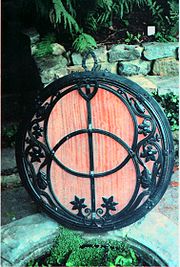
Chalice Well
Encyclopedia
siteentrance.jpg)

sevenbowlsvesicapool.jpg)
lionsheadfountain.jpg)

Water well
A water well is an excavation or structure created in the ground by digging, driving, boring or drilling to access groundwater in underground aquifers. The well water is drawn by an electric submersible pump, a trash pump, a vertical turbine pump, a handpump or a mechanical pump...
situated at the foot of Glastonbury Tor
Glastonbury Tor
Glastonbury Tor is a hill at Glastonbury, Somerset, England, which features the roofless St. Michael's Tower. The site is managed by the National Trust. It has been designated as a Scheduled Ancient Monument ....
in the county of Somerset
Somerset
The ceremonial and non-metropolitan county of Somerset in South West England borders Bristol and Gloucestershire to the north, Wiltshire to the east, Dorset to the south-east, and Devon to the south-west. It is partly bounded to the north and west by the Bristol Channel and the estuary of the...
, England
England
England is a country that is part of the United Kingdom. It shares land borders with Scotland to the north and Wales to the west; the Irish Sea is to the north west, the Celtic Sea to the south west, with the North Sea to the east and the English Channel to the south separating it from continental...
. The natural spring and surrounding gardens are owned and managed by the Chalice Well Trust (registered charity no. 204206), founded by Wellesley Tudor Pole
Wellesley Tudor Pole
Major Wellesley Tudor Pole O.B.E. was a spiritualist and early British Bahá'í.He authored many pamphlets and books and was a lifelong pursuer of religious and mystical questions and visions, being particularly involved with spiritualism and the Bahá'í Faith as well as the quest for the Holy Grail...
in 1959.
Archaeological
Archaeology
Archaeology, or archeology , is the study of human society, primarily through the recovery and analysis of the material culture and environmental data that they have left behind, which includes artifacts, architecture, biofacts and cultural landscapes...
evidence suggests that the well has been in almost constant use for at least two thousand years. Water issues from the spring at a rate of 25,000 gallon
Gallon
The gallon is a measure of volume. Historically it has had many different definitions, but there are three definitions in current use: the imperial gallon which is used in the United Kingdom and semi-officially within Canada, the United States liquid gallon and the lesser used United States dry...
s per day and has never failed, even during drought. Iron oxide
Iron oxide
Iron oxides are chemical compounds composed of iron and oxygen. All together, there are sixteen known iron oxides and oxyhydroxides.Iron oxides and oxide-hydroxides are widespread in nature, play an important role in many geological and biological processes, and are widely utilized by humans, e.g.,...
deposits give water a reddish hue, as dissolved ferrous oxide becomes oxidized at the surface and is precipitated. Like the hot springs in nearby Bath, the water is believed to possess healing qualities.
In addition to the legends associated with Glastonbury, the Well is often portrayed as a symbol of the female aspect of deity
Deity
A deity is a recognized preternatural or supernatural immortal being, who may be thought of as holy, divine, or sacred, held in high regard, and respected by believers....
, with the male symbolised by Glastonbury Tor
Glastonbury Tor
Glastonbury Tor is a hill at Glastonbury, Somerset, England, which features the roofless St. Michael's Tower. The site is managed by the National Trust. It has been designated as a Scheduled Ancient Monument ....
. As such, it is a popular destination for pilgrim
Pilgrim
A pilgrim is a traveler who is on a journey to a holy place. Typically, this is a physical journeying to some place of special significance to the adherent of a particular religious belief system...
s in search of the divine feminine, including Neopagans
Neopaganism
Neopaganism is an umbrella term used to identify a wide variety of modern religious movements, particularly those influenced by or claiming to be derived from the various pagan beliefs of pre-modern Europe...
. The Well is however popular with all faiths and in 2001 became a World Peace Garden.
Wells often feature in Welsh
Welsh mythology
Welsh mythology, the remnants of the mythology of the pre-Christian Britons, has come down to us in much altered form in medieval Welsh manuscripts such as the Red Book of Hergest, the White Book of Rhydderch, the Book of Aneirin and the Book of Taliesin....
and Irish mythology
Irish mythology
The mythology of pre-Christian Ireland did not entirely survive the conversion to Christianity, but much of it was preserved, shorn of its religious meanings, in medieval Irish literature, which represents the most extensive and best preserved of all the branch and the Historical Cycle. There are...
as gateways to the spirit world. The overlapping of the inner and outer worlds is represented by the well cover, designed by the church architect and archaeologist Frederick Bligh Bond
Frederick Bligh Bond
Frederick Bligh Bond was an English architect, illustrator, archaeologist, and psychical researcher.-Early life:...
and presented as a gift after the Great War in 1919. The two interlocking circles constitute the symbol known as the Vesica Piscis
Vesica piscis
The vesica piscis is a shape that is the intersection of two circles with the same radius, intersecting in such a way that the center of each circle lies on the circumference of the other. The name literally means the "bladder of a fish" in Latin...
. In the well lid design, a spear or a sword bisects these two circles, a possible reference to Excalibur
Excalibur
Excalibur is the legendary sword of King Arthur, sometimes attributed with magical powers or associated with the rightful sovereignty of Great Britain. Sometimes Excalibur and the Sword in the Stone are said to be the same weapon, but in most versions they are considered separate. The sword was...
, the sword of the legendary King Arthur
King Arthur
King Arthur is a legendary British leader of the late 5th and early 6th centuries, who, according to Medieval histories and romances, led the defence of Britain against Saxon invaders in the early 6th century. The details of Arthur's story are mainly composed of folklore and literary invention, and...
, believed by some to be buried at the nearby Glastonbury Abbey
Glastonbury Abbey
Glastonbury Abbey was a monastery in Glastonbury, Somerset, England. The ruins are now a grade I listed building, and a Scheduled Ancient Monument and are open as a visitor attraction....
. Foliage represents the Glastonbury Holy Thorn. Bligh Bond wrote that the vesica design for the well cover was "typical of many early diagrams, all having the same object – the rendering of spiritual truth by means of the purest, most intellectual system of imagery conceived by the mind, namely, truth which is ‘aeonial’ or eternal, of which geometry is the best interpreter, since it can figure for us with remarkable suggestiveness those formative principles upon which the Father has built his Creation, principles which shall endure when heaven and earth have died ." (Ref. Central Somerset Gazette, Friday, November 14, 1919)
Christian mythology
Christian mythology
Christian mythology is the body of myths associated with Christianity. In the study of mythology, the term "myth" refers to a traditional story, often one which is regarded as sacred and which explains how the world and its inhabitants came to have their present form.Classicist G.S. Kirk defines a...
suggests that Chalice Well marks the site where Joseph of Arimathea
Joseph of Arimathea
Joseph of Arimathea was, according to the Gospels, the man who donated his own prepared tomb for the burial of Jesus after Jesus' Crucifixion. He is mentioned in all four Gospels.-Gospel references:...
placed the chalice that had caught the drops of Christ
Christ
Christ is the English term for the Greek meaning "the anointed one". It is a translation of the Hebrew , usually transliterated into English as Messiah or Mashiach...
's blood at the Crucifixion, linking the Well to the wealth of speculation surrounding the existence of the Holy Grail
Holy Grail
The Holy Grail is a sacred object figuring in literature and certain Christian traditions, most often identified with the dish, plate, or cup used by Jesus at the Last Supper and said to possess miraculous powers...
. The red of the water is also said by some Christians to represent the rusty iron nails used at the Crucifixion
Crucifixion
Crucifixion is an ancient method of painful execution in which the condemned person is tied or nailed to a large wooden cross and left to hang until dead...
. Frequent events are held in the grounds of Chalice Well including annual celebrations for the winter
Winter solstice
Winter solstice may refer to:* Winter solstice, astronomical event* Winter Solstice , former band* Winter Solstice: North , seasonal songs* Winter Solstice , 2005 American film...
and summer solstice
Solstice
A solstice is an astronomical event that happens twice each year when the Sun's apparent position in the sky, as viewed from Earth, reaches its northernmost or southernmost extremes...
s, World Peace Day, Easter
Easter
Easter is the central feast in the Christian liturgical year. According to the Canonical gospels, Jesus rose from the dead on the third day after his crucifixion. His resurrection is celebrated on Easter Day or Easter Sunday...
, Michaelmas
Michaelmas
Michaelmas, the feast of Saint Michael the Archangel is a day in the Western Christian calendar which occurs on 29 September...
and Samhain
Samhain
Samhain is a Gaelic harvest festival held on October 31–November 1. It was linked to festivals held around the same time in other Celtic cultures, and was popularised as the "Celtic New Year" from the late 19th century, following Sir John Rhys and Sir James Frazer...
(Halloween
Halloween
Hallowe'en , also known as Halloween or All Hallows' Eve, is a yearly holiday observed around the world on October 31, the night before All Saints' Day...
). It is a grade I listed building.

